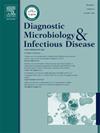Whole genome sequencing and phylogenetic analysis to examine acquisition of Escherichia coli clones during international travel
IF 2.1
4区 医学
Q3 INFECTIOUS DISEASES
Diagnostic microbiology and infectious disease
Pub Date : 2025-01-18
DOI:10.1016/j.diagmicrobio.2025.116701
引用次数: 0
Abstract
International travel facilitates the acquisition and carriage of extended-spectrum beta-lactamase-producing Escherichia coli (ESBL-E). We describe genomes of predominant ESBL-E clones detected before and after travel among subjects departing from Rio de Janeiro, Brazil, during 2015-2021, and genomes publicly available from countries visited by travelers. WGS (Illumina NovaSeq) was performed on 70 ESBL-E isolates from 66 travelers (18 pre- and 52 post-travel). Sequence type (ST), antimicrobial resistance (AMR), virulence genes, and plasmids were determined by Center for Genomic Epidemiology tools. Phylogenetic trees were constructed with each of the most frequent ST of travelers’ genomes (TG) and genomes with the same ST from Enterobase (EG). Other analyses were performed with Prokka, Roary, SNP-sites, and FastTree. Trees were visualized with iTOL. Among 70 ESBL-E, the clonal composition was quite diverse, with 41 different ST, with predominance before of CC10 and CC131, and after travel, CC10, CC131, CC69, and CC38, and three ST described for the first time: ST14408 and ST14412 (CC10), and ST4411 (CC20). Core genome phylogenetic analysis revealed 17 clusters, eight of which formed by post-travel TG and EG detected in the same country visited by traveler. We observed an increased number and diversity of AMR genes, plasmids, and virulence genes in post-travel isolates, although we only found statistical significance for IncFIB plasmid. Genome clustering supported the high-risk clone acquisition and AMR during international trips. More than half of detected clones were related to ExPEC and showed an increased number and diversity of AMR and virulence-related genes, as well as plasmids in post-travel isolates.
求助全文
约1分钟内获得全文
求助全文
来源期刊
CiteScore
5.30
自引率
3.40%
发文量
149
审稿时长
56 days
期刊介绍:
Diagnostic Microbiology and Infectious Disease keeps you informed of the latest developments in clinical microbiology and the diagnosis and treatment of infectious diseases. Packed with rigorously peer-reviewed articles and studies in bacteriology, immunology, immunoserology, infectious diseases, mycology, parasitology, and virology, the journal examines new procedures, unusual cases, controversial issues, and important new literature. Diagnostic Microbiology and Infectious Disease distinguished independent editorial board, consisting of experts from many medical specialties, ensures you extensive and authoritative coverage.

 求助内容:
求助内容: 应助结果提醒方式:
应助结果提醒方式:


